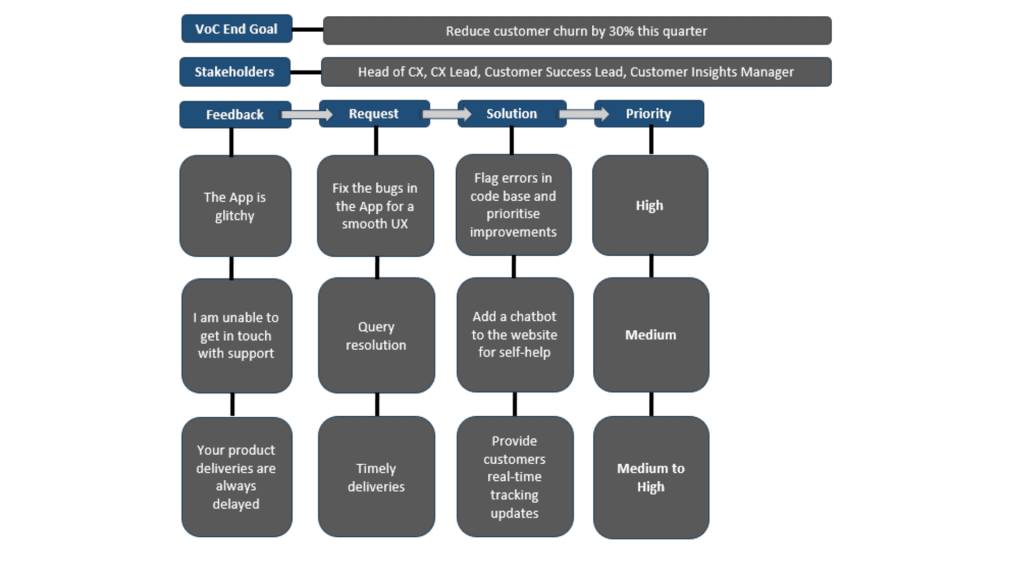

Learn how to gather and implement actionable customer feedback with our Voice of Customer template


You’ve just launched a shiny new product. You’re proud of it, your team is excited, and you know it’s going to be a hit with customers. But weeks go by, and the results are… underwhelming. Sales are trickling in, reviews are few and far between, and you’re starting to wonder if you’ve missed the mark.
You know your product is great, but here’s the thing—you don’t know what your customers think. Are they loving it? Are they confused about how to use it? Are they finding small issues you haven’t even thought about? Without feedback, you’re flying blind.
This is where the Voice of the Customer (VoC) comes in. It’s like turning on a light in a room you’ve been stumbling around in for hours. Suddenly, you can see clearly. You know what your customers are thinking, feeling, and saying—and with that knowledge, you can take action.
In this article we are going to discuss:
At its core, Voice of the Customer is about listening. It’s not just collecting feedback—it’s truly understanding your customers’ experiences, frustrations, and desires. Think of it like sitting down with your customers for a coffee and having an honest conversation about what’s working and what isn’t. That insight is gold.
Whether you’re launching a product, improving your service, or just wanting to know how people feel about your brand, VoC gives you the map to navigate customer needs. The best part? You don’t need to guess—you’ll know exactly where to focus your energy.
Let’s say you’ve got feedback coming from everywhere—customer emails, social media mentions, support tickets, reviews, surveys… it’s a lot to manage. Without a system, you’re left with bits and pieces, like trying to complete a puzzle when half the pieces are missing. A VoC template is your puzzle box, neatly organizing all those pieces so you can finally see the full picture.
Here’s why you need one:
Consistency: You’re getting the same kind of feedback from everyone, making it easier to see trends and spot patterns.
Efficiency: No more scrambling through emails and post-its for feedback. It’s all in one place, ready for action.
Actionable insights: Instead of guessing what to do next, a VoC template helps you turn customer comments into specific steps for improvement.
A Voice of the Customer (VoC) template is an essential business tool for collecting and analyzing customer feedback on products or services. It’s structured to enhance understanding of customer needs and refine offerings. Key elements include:
Gathers basic customer details like demographics for contextual feedback.
This may involve open-ended questions for in-depth insights and rating scales for measuring satisfaction and recommendation likelihood.
Allocates space for noting necessary responses to feedback, such as further customer engagement or issue resolution.
Incorporates methods to analyze feedback, identifying trends and areas needing attention.
Imagine you’re running a bustling café, serving up the best coffee in town. At least, you think it’s the best. But something strange is happening. Regulars who used to come in every day are slowly disappearing. You start to wonder if something’s wrong, but no one’s telling you directly.
One day, a customer finally speaks up. “The coffee’s great, but the wait time? Not so much.” That’s the first honest piece of feedback you’ve gotten in a while. And suddenly, you realize there’s a pattern. People love your coffee, but your service is slow, and they’re not willing to wait. With this new insight, you add another barista during peak hours—and voilà, your regulars start coming back.
That’s the power of listening to the Voice of the Customer. Your customers know what’s working and what isn’t—if you’re ready to listen.
The first step is to collect customer feedback from various sources. This includes surveys, interviews, focus groups, social media listening, and customer support interactions. It’s essential to gather a mix of qualitative and quantitative data to get a comprehensive understanding of customer needs, preferences, and pain points. Here are some effective ways to connect with your customers and get their valuable insights
Get up close and personal with your customers by conducting in-person, phone, or email interviews. Ask open-ended questions to dig into their thoughts on your products, services, and overall experiences. Building a personal connection will help you gain their trust and uncover valuable insights.
Utilize online platforms like Typeform or Eclipse AI survey tool to create engaging surveys that cover various aspects of the customer experience, including satisfaction, product features, and service quality. Be sure to keep the surveys concise and relevant to your customer base.
Don’t forget to keep an eye on your social media platforms! Monitor customer feedback and engage in conversations to show that you’re listening. Use social listening tools to track mentions of your brand and respond to customer comments and queries. You can even create surveys directly on platforms like Twitter or LinkedIn.
Understand how your customers interact with your website by implementing tools like Hotjar or CrazyEgg. Look for patterns in page visits, time spent on pages, and click rates to understand user behavior and preferences.
Send out short surveys asking customers how likely they are to recommend your product or service to others. Analyze the responses to categorize customers into promoters, passives, and detractors, and use the feedback to identify areas of improvement.
Analysing the voice of the customer data involves looking for common themes, identifying areas for improvement, and understanding customer expectations. Advanced analytics tools can be helpful in this stage, allowing for deeper insights and trends to emerge from the data. Many companies, including Amazon, have successfully leveraged customer feedback. Consider the following when analysing the customer data.
Look for common themes across different feedback channels. This might include recurring complaints, praises, or suggestions.
Not all feedback will be equally important. Prioritize based on what aligns best with your business goals and customer satisfaction.
AI-powered customer analytics platform can help CX teams get more insightful actionable insights faster. A study by Temkin Group found that companies that earn $1 billion annually can expect to earn an additional $700 million within three years of investing in CX improvements.
The final step is to act on the insights gained from your VoC data. This may involve making changes to products or services, improving customer service, or adjusting business strategies. It’s crucial to not only implement these changes but also to communicate back to customers how their feedback has led to tangible improvements. This closes the feedback loop and enhances customer engagement and loyalty.
By following these three steps and implementing voice of the customer best practices, you can establish an effective VoC program that will help you gain valuable insights into your customer’s needs and preferences, improve your overall customer experience, and drive business growth.
VoC template enables businesses to systematically understand and respond to customer needs, enhancing satisfaction and fostering continuous improvement. Below is an example of a comprehensive VoC template that is free for you to download.


In the ever-evolving landscape of business, Customer Experience Analytics is now seen as the lynchpin for companies keen on establishing a remarkable presence in the customers’ minds. At Eclipse AI, we understand its crucial role and how it rebirths the norms of customer interactions. Here, we’ll dive deep into the less-charted waters of customer experience, shedding light on nuanced strategies and statistics that underline the transformative power of truly understanding the customers.
In the ever-evolving landscape of business, Customer Experience Analytics is now seen as the lynchpin for companies keen on establishing a remarkable presence in the customers’ minds. At Eclipse AI, we understand its crucial role and how it rebirths the norms of customer interactions. Here, we’ll dive deep into the less-charted waters of customer experience, shedding light on nuanced strategies and statistics that underline the transformative power of truly understanding the customers.
Share this article




Don’t Let Your Competitors Understand Your Customers Better Than You
Don’t miss out. Try our 30-day Free Professional Trial.

